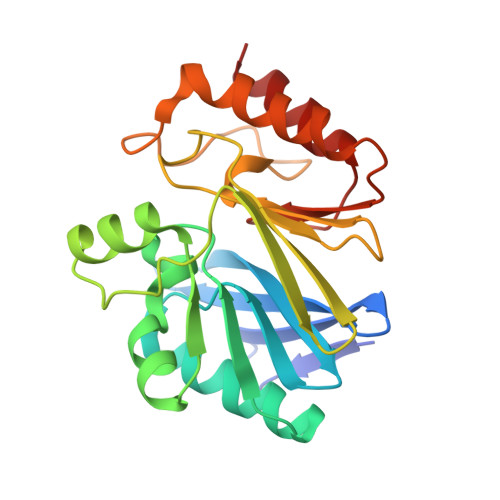Effect of Ph on the Active Site of an Arg121Cys Mutant of the Metallo-Beta-Lactamase from Bacillus Cereus: Implications for the Enzyme Mechanism.
Davies, A.M., Rasia, R.M., Vila, A.J., Sutton, B.J., Fabiane, S.M.(2005) Biochemistry 44: 4841
- PubMed: 15779910
- DOI: https://doi.org/10.1021/bi047709t
- Primary Citation of Related Structures:
2BFK, 2BFL, 2BFZ, 2BG2, 2BG6, 2BG7, 2BG8, 2BGA - PubMed Abstract:
The zinc-dependent metallo-beta-lactamases are a group of bacterial enzymes that pose a threat to the future efficacy of present-day antibiotics. Their mechanism is poorly understood, and there are no clinically useful inhibitors. While most members of the group contain two tightly bound zinc ions in their active sites, the Bacillus cereus enzyme has a much lower affinity for its second zinc (Zn2), thought to be due to the presence of Arg121 immediately beneath the floor of the active site (cf. Cys/Ser/His121 in the bizinc enzymes). Crystal structures of the Arg121Cys mutant of the B. cereus 569/H/9 enzyme were solved at pH 7.0, 5.0, and 4.5, each in the presence of either 20 microM or 20 mM Zn(2+) to generate the mono- and bizinc forms, respectively. Surprisingly, the structure of the active site was unaffected by the mutation; a network of ordered water molecules replaced the interactions made by the arginine side chain, and the occupancy of Zn2 appeared minimally changed. As the pH was lowered, Zn2 moved away from one of its ligands, Asp120, but was "tracked" by two others, Cys221 and His263. Furthermore, the hydroxide ion (and proposed nucleophile for beta-lactam hydrolysis) was bound to Zn1 at pH 5 and above but absent at pH 4.5. This provides experimental evidence for an earlier proposed mechanism in which protonation of Asp120 and the Zn1-bound hydroxide are the two events that lead to the loss of activity at low pH.
Organizational Affiliation:
Randall Division of Cell and Molecular Biophysics, King's College London, New Hunt's House, Guy's Campus, London Bridge, SE1 1UL, London, United Kingdom.


















